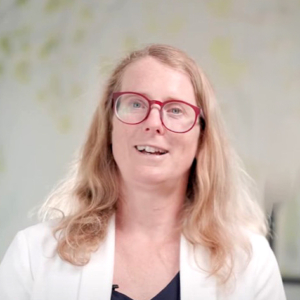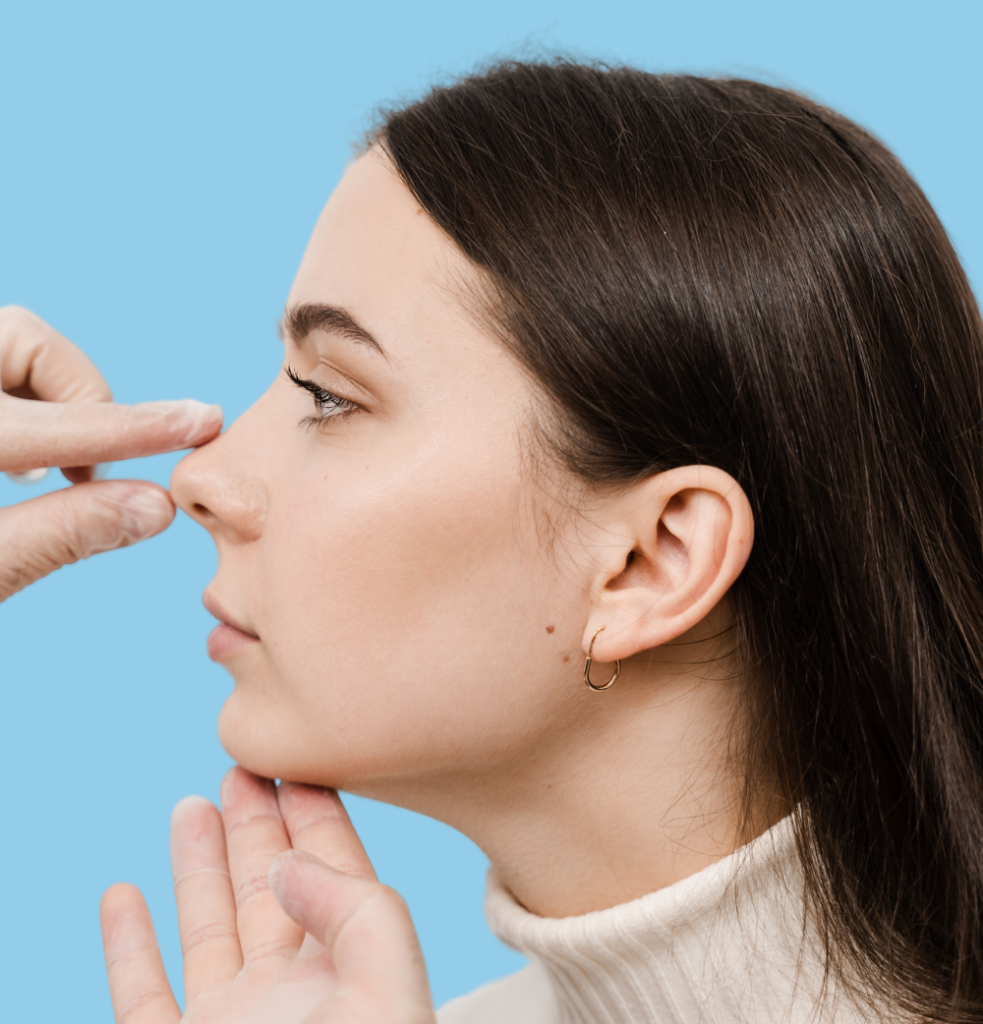
Common Nose Shapes And Their Treatments
Many people have specific concerns about their nose shape and facial aesthetics. Among the most common issues are a flat nose bridge, a droopy tip, and a broad base. Each of these features can affect the appearance of the nose and, consequently, the balance and harmony of the face.
There are non-surgical and surgical treatment options available, and it can be confusing to know which treatment is right for you. Let’s examine the nose shapes people find most bothersome and how to correct them.
What nose shapes do people worry about
People have many different concerns about their noses, but the main concerns we see at our clinic are a flat nose bridge, droopy nose tips, and a broad nose base. People want these issues fixed, and non-surgical options to correct them have become quite popular.
Whereas non-surgical treatment can correct these aspects of the nose, it can not correct the nose’s structure. So, if you think your nose is too big or not straight enough or you don’t like its shape as a whole, you may need surgery.
Rhinoplasty is a surgical option for altering the shape of your nose. It can address concerns such as bumps or a curved appearance.
Which nose shapes can you correct without surgery?
Non-surgical options can only achieve subtle changes in your nose shape. Most commonly, we can correct a flat nose bridge, a droopy tip, or a broad base. If you have more complex issues with your nose, you may prefer to seek a surgical opinion.
Flat Nose Bridge
This is a widespread concern, especially among Asian people. A flat nose bridge lacks the height and definition that some individuals desire. This can create a less pronounced profile and affect the overall contour of the face. Many people want a more defined bridge to enhance their facial profile and achieve a balanced appearance.
Droopy Tip of the Nose
A droopy tip can make the nose appear longer and downturned. This can be due to genetics, aging, or structural factors within the nose. Lifting and reshaping the tip of your nose can boost your confidence.
Broad Base of the Nose
A broad nose base can make the nose appear more prominent than the rest of the face. Some people may not like this look. Narrowing the base of your nose can make your face look more balanced and harmonious. This can give you a more refined appearance.
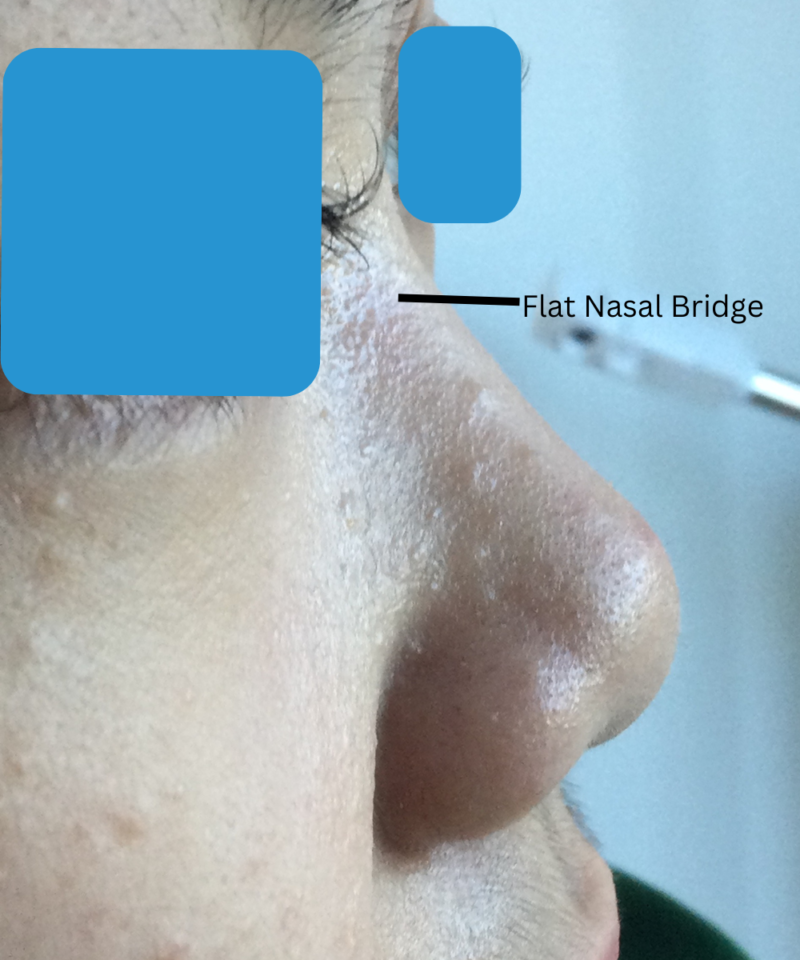
Flat Nasal Bridge
What should I choose for my nose?
It really depends on what you would like to change and how far ou want to take things. The table shows you a few pros and cons.
| Non-Surgical Nose Job | Surgical Nose Job | |
|---|---|---|
| Corrects Nose Shapes |
|
|
| Advantages |
|
|
| Disadvantages |
|
|
| In summary | Enhances certain aspects of the nose | Can improve the structure of the nose |
How do you correct these nose shapes without surgery?
We offer two main non-surgical treatments to improve the shape of your nose. These include PDO threads or Botox. These treatments work well for a flat nose bridge, broad nose base or droopy nose tip.
Nose lift with PDO MINT Threads.
PDO (Polydioxanone) MINT Threads provide a non-surgical alternative to rhinoplasty. We strategically insert these threads to lift and reshape the nose. Threads are popular for defining the nasal bridge and lifting the tip of the nose.
Results are immediate with minimal downtime. Over time, the threads stimulate collagen production, enhancing the skin’s firmness and elasticity. This natural process helps maintain the nose’s new shape and improves skin texture. Results usually last between 12 to 18 months.
How long does a PDO Thread Noselift take?
The procedure typically lasts 30-45 minutes. It is a quick and convenient option for those looking to enhance their nose without surgery.
Is the procedure uncomfortable?
Patients expect minimal discomfort during the procedure because the provider applies a numbing cream to the treatment area beforehand. After that, the doctor will gently inject a local anaesthetic. Most people will notice pulling and pushing during the insertion of the threads, but no pain.
Will I get a lot of bruising and swelling?
After the treatment, some swelling and bruising may occur, but these side effects usually subside within a few days.
Do I need downtime?
Most people can resume their normal activities immediately after the procedure without extended downtime. However, we recommend allowing some extra rest during the day. PDO MINT Threads offer a safe and effective way to achieve a more defined and lifted nose. This method avoids the risks and recovery time associated with traditional rhinoplasty.ermal filler for the nose.
Before And After Non-Surgical Noselift with PDO Threads
This young woman in her 30s wanted her flat nose bridge improved. She required two PDO threads to lift the bridge. Results usually last for 12 to 18 months.
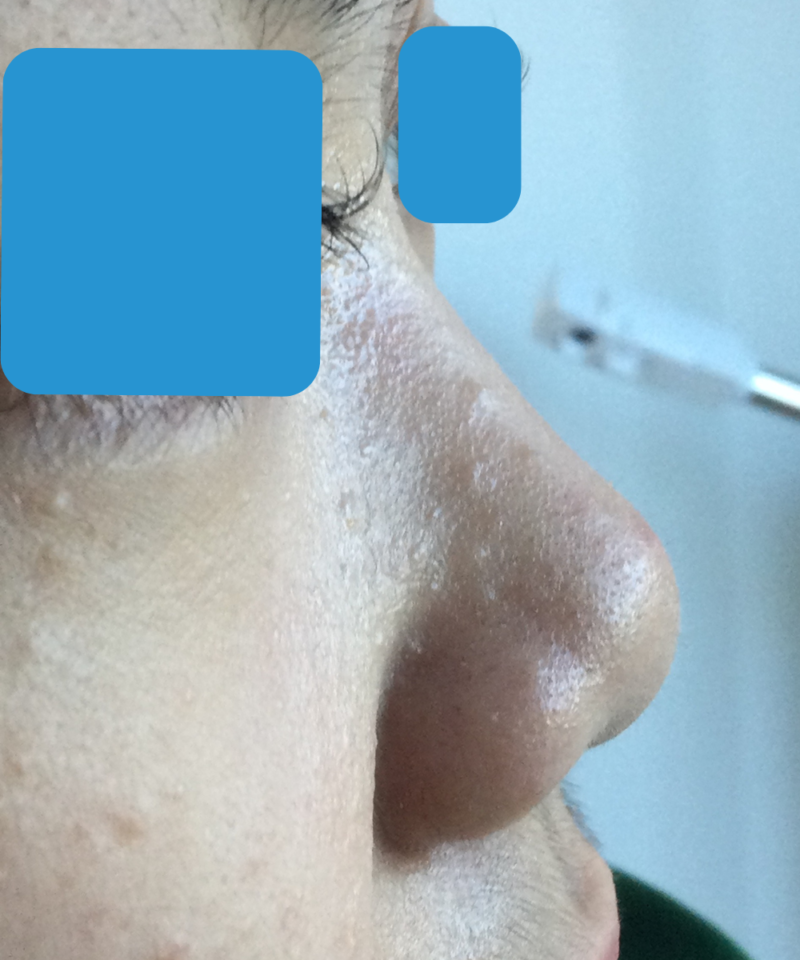
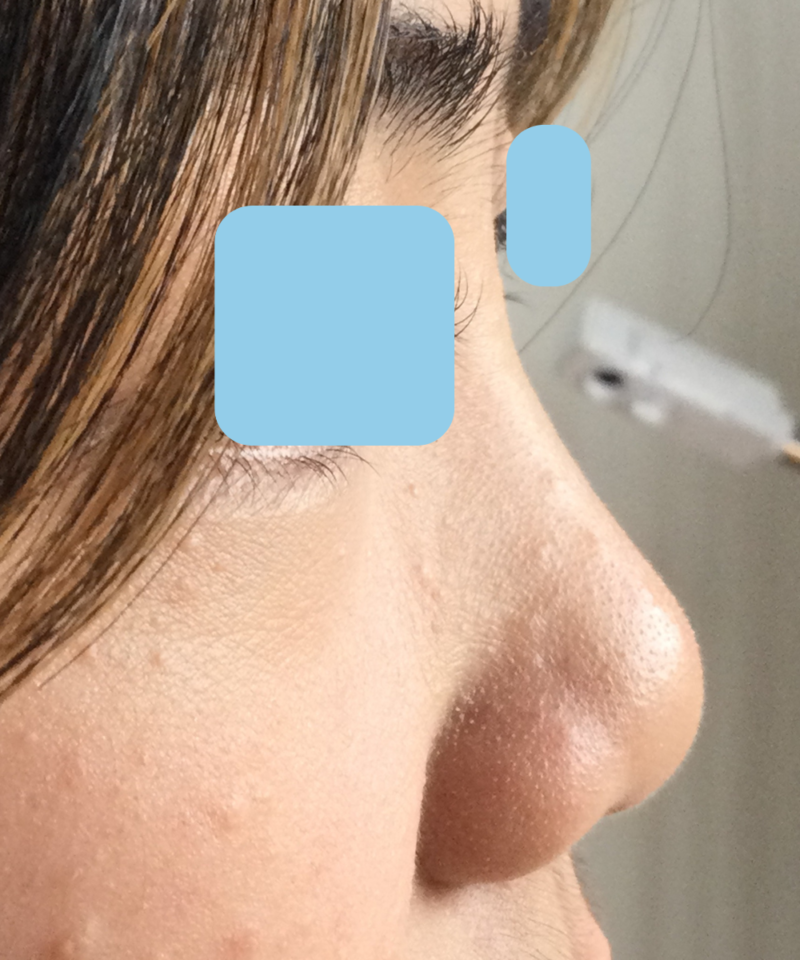
Botox for the nose
Botox injections can refine the nose shape by relaxing the muscles that cause a droopy tip or wide nostrils. This small change can raise the tip of the nose and make the base narrower, giving a more balanced look.
Nose Botox is a common choice for people who want a temporary way to slim their nose without having surgery.
How long does it last?
Botox effects on the nose usually last 3-4 months. Then, muscles regain strength, and the nose will return to its original shape. Regular maintenance treatments can help maintain the results for longer periods.
Dermal filler for the nose
In many countries, people commonly use dermal fillers for cosmetic enhancements. But this can be a risky procedure for reshaping the nose. We do not recommend using dermal fillers for the nose because of the potential risk of blindness.
The nose contains a complex network of blood vessels that closely connect to the blood supply of the eyes. Injecting fillers into the nose can accidentally block a blood vessel.
A blockage in a blood vessel supplying the eye can result in vision loss or blindness. Because of that reason, we do not recommend dermal filler for the nose.
Which Nose Shape Is Best To Correct Surgically
A rhinoplasty can make the nose look more balanced and attractive by narrowing the nostrils and base. Surgery’s results are better and longer-lasting than non-surgical options, but it is more invasive and requires anesthesia.
What nose shapes respond better to surgical procedures?
Sometimes, nose surgery may be the better option. The non-surgical options can only improve a few aspects of the nose. So, to reshape your whole nose, it is often better to consult an ear-nose-throat surgeon to discuss a rhinoplasty.
For example, some people may not find the nose shapes below attractive and may consider getting treatment.
Snub nose (Button nose)
A snub nose is a nose shape characterized by a short, upturned nose tip with a slightly concave bridge. So, in summary, this type of nose is short and turned up at the end. The contour is often soft and smooth.
Celestial nose
A celestial nose has a straight bridge and a slightly upturned tip. Sculptures of gods and goddesses often depict this type of nose.
Greek nose
A Greek nose has a straight bridge and a slightly upturned tip, similar to those seen in sculptures of gods and goddesses.
Too large nose
A nose that is too large requires a rhinoplasty that reduces the size of the nose. Non-surgical treatments such as PDO threads or Botox cannot achieve this.
Pros of a non-surgical nose job
A non-surgical nose job, such as PDO threads, can alter the shape of the nose without the need to go under the knife. A popular alternative if you want to enhance your nose without the risks and downtime of surgery is available. Here are some pros of this procedure:
Minimally Invasive
This procedure does not involve extensive incisions or surgical procedures, reducing the risk of complications and infection.
Quick Procedure
The process is usually fast, often completed in under an hour, making it convenient for those with busy schedules.
Immediate Results
Unlike surgical rhinoplasty, which requires a longer healing time, you will typically see immediate improvements.
Lower Cost
Non-surgical nose jobs are cheaper than surgery, so more people can afford them.
Temporary Changes
PDO threads are temporary, allowing you to make subtle changes to your appearance without committing to permanent alterations. The threads will eventually wear off if you are unhappy with the results.
Minimal Downtime
Most people experience little to no downtime, allowing them to return to normal activities almost immediately.
No General Anesthesia
The procedure typically uses only local anesthesia or numbing agents, reducing the risks associated with general anesthesia.
Less Pain and Discomfort
Compared to surgical rhinoplasty, a non-surgical nose job is usually less painful and requires less recovery.
CONS of a non-surgical nose shape correction
While a non-surgical nose job has many benefits, there are also several cons to consider:
Temporary Results
Non-surgical nose jobs are not permanent, typically lasting six months to two years. This means repeat treatments are necessary to maintain the desired look. If you only want to slim your nose with Botox, renew it every 3 to 4 months.
Limited Scope of Changes
Non-surgical rhinoplasty is best for making minor changes to the nose. But it can’t fix big problems like a crooked septum or making the nose smaller.
Cost Over Time
At first, non-surgical treatments may seem cheaper than surgery. However, the cost of regular treatments to maintain results can accumulate over time. This can end up being more expensive in the long term.

Snub nose

Large Nose

Greek Nose
PROS of a rhinoplasty
Permanent Results
The changes made during rhinoplasty are permanent, providing long-lasting results.
Comprehensive Correction
Rhinoplasty can improve the appearance and function of your nose. Nose corrections can include making it smaller, reshaping the tip, narrowing the nostrils, and fixing a crooked septum.
Enhanced Breathing
Nose surgery can help improve breathing by fixing issues such as a crooked septum or weak nasal valves. This can significantly improve your quality of life.
One-Time Procedure
Since the results are permanent, rhinoplasty is typically a one-time procedure, unlike non-surgical options that require maintenance.
CONS of a rhinoplasty
Surgical Risks
As with any surgery, rhinoplasty carries risks such as infection, bleeding, and complications related to anesthesia.
Recovery Time
The recovery period can be significant, often involving several weeks of swelling, bruising, and discomfort. Full recovery and final results may take up to a year.
Cost
Rhinoplasty can cost a lot because many insurance companies view it as a cosmetic procedure. Insurance may not cover the cost unless a medical professional deems it necessary.
Irreversibility
Once the surgeon performs the surgery, it remains permanent. Corrective or revision surgeries can be more complex and may not always achieve the desired outcome.
Scarring
Although modern techniques minimize scarring, visible scars are still possible, particularly with open rhinoplasty.
Pain and Discomfort
Post-operative pain and discomfort are common and require pain management and rest during the initial recovery period.
Changes Over Time
The nose can continue to change shape slightly as a person ages, which might affect the long-term appearance of the results.
Book Your Appointment
Many people want to improve their facial features by correcting issues like a flat nose bridge, droopy tip, and broad base. We offer non-surgical treatments for these problems. If we think a surgical solution for your nose shape is more suitable, we can refer you to a skilled surgeon.
Chatting with a cosmetic doctor at Satini Cosmetic Clinic can help you determine the best way to reach your goals.

